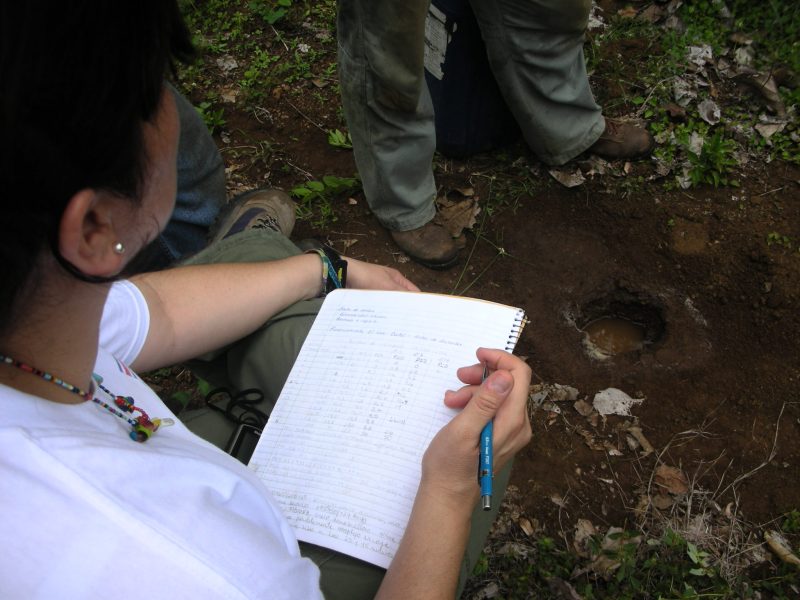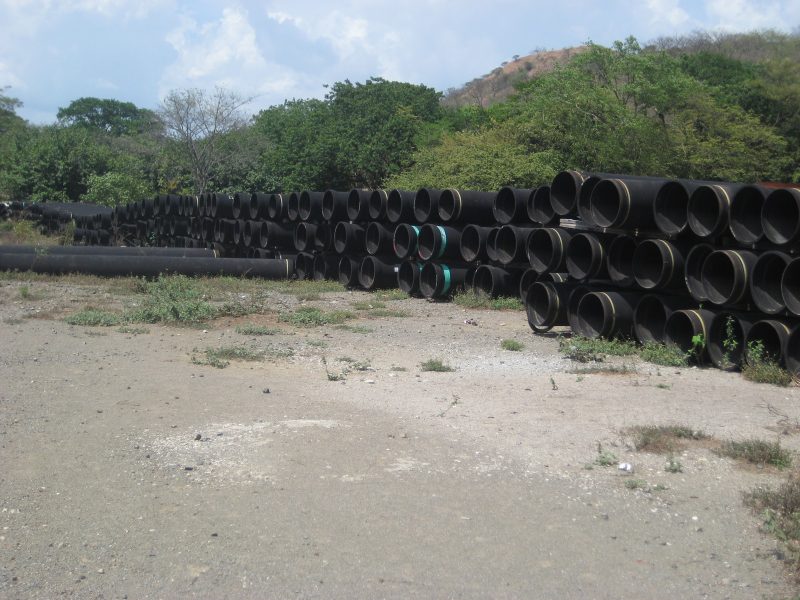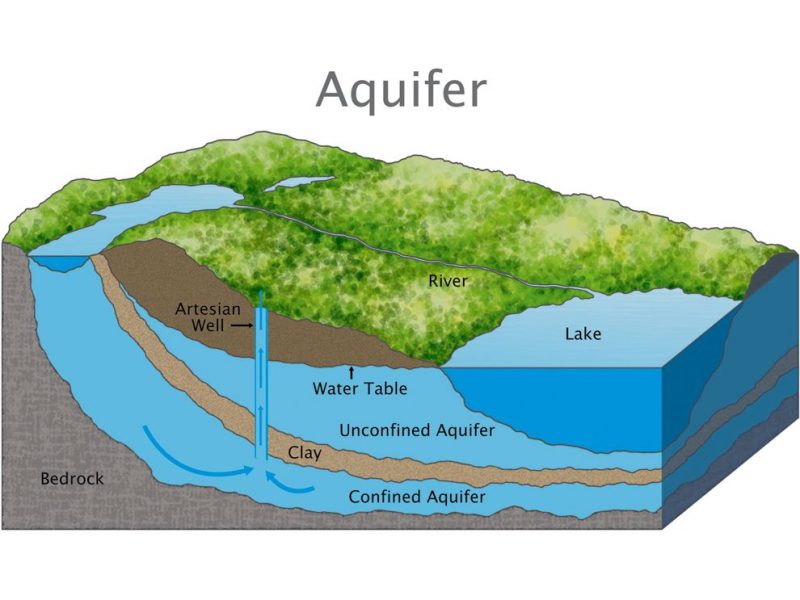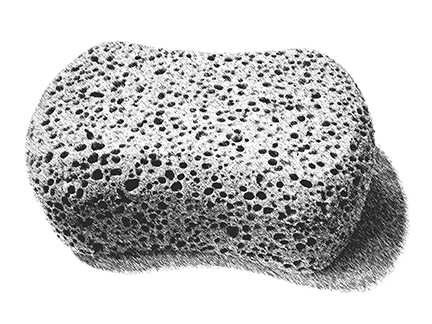I conducted my first hydrogeological infiltration tests in 2008. At the time, the task seemed daunting. Hydrogeology as a discipline challenges our familiar temporal and spatial parameters. This first became evident when I leaned over a hole watching water slowly dissolve while discussing with scientists from the Underground Water Research Agency in Costa Rica how texture, granularity, and seepage affected water flow. What came next posed the real challenge. Wrapping my head around the peculiar space-time of an aquifer required a four-dimensional imaginary that simultaneously considered multidirectional pressures and converging and diverging movements, all in flux due to the passage of time.

Infiltration test results being recorded.
The infiltration speed that we recorded that day would undergo many transformations until, combined with other data points, it gave some clues about what the aquifer we were studying could do for the town of Sardinal and for the new tourism developments investors were building in the touristy province of Guanacaste. In previous years, developers had raised $8 million to connect their new construction to the Sardinal aqueduct, a system built more than four decades earlier that extracted the liquid from the Sardinal aquifer to supply local populations. Taking advantage of the access they had to central governmental authorities, investors agreed with the country’s largest utility, an entity owned by the state, to fund the expansion of the aqueduct in exchange for guaranteed access to the water the new infrastructure would make available.
Despite the public relations efforts of both the investors and the utility, activists and Sardinal residents unearthed a series of inconsistencies and illegalities in the project. Most crucially, they found no appropriate hydrogeological study to support the water extraction rate that the utility had guaranteed investors. There was no acceptable basic model rendering the qualities of the aquifer and the quantity of water it could provide. That quantity is calculated through an extraction rate, a number that defines the volume of water that can be extracted from an aquifer per unit of time, such as liters or cubic meters per second. An extraction rate can have a broad significance; for instance, in the case of Sardinal it came to reflect the historical struggles and environmental worries behind the decision to use underground water for commercial enterprises, especially under conditions of scarcity.
A collective comprising residents, students from an environmental extension program from the University of Costa Rica, and environmental activists challenged the supposed environmental viability of the water extraction rate endorsed by the utility, municipal council, and investors. They opposed the project by arguing that the extraction rate guaranteed to the developers would sooner or later deplete the aquifer and, most crucially, that such a rate was another instance of authorities making decisions to benefit investors and not local residents. But once the news that there was no solid hydrogeological model backing up the project circulated, the conflict changed in nature, moving from a dispute over an extraction rate that could potentially be resolved by changing it, to a dispute over the very conceptualization of the aquifer, a struggle over what kind of entity it was. In the process, an old, latent conflict between investors and residents turned into a confrontation that resulted in protests, arrests, and a legal order to suspend work. That year, the Sardinal conflict became an icon of water struggles in Costa Rica.
Law, Bureaucracy, Science
In several legal actions from all parties, courts sided with those opposing the project. In their decisions, different judges noted how scandalous it was that despite completing most of the construction work (about 75% of the project) and launching international marketing campaigns promoting luxury accommodations to American and Canadian expats and tourists, those responsible for the construction of the new infrastructure still “ignored” what the aquifer really was; the details of its material constitution remained opaque. As a result, the courts mandated public institutions with jurisdiction over water to produce the missing model. The infiltration tests that introduced me to hydrogeological thinking were performed in response to the court’s ruling and were directly supervised by an inter-institutional committee of state entities established to study the situation. Once the missing model was developed, that committee would determine the viability of any plan to tap water from the Sardinal aquifer. Thus, technoscience was commissioned to resolve the Sardinal dispute.

Pipes waiting to be installed near Sardinal.
Once the conflict turned into a struggle over the very nature of the aquifer and its legitimate use, local residents expressed on many occasions that they would not let the developers take water from Sardinal “with or without a permit.” The utility, on the other hand, spun the project as a necessary investment to create new jobs in tourism, an activity that employs most residents in the area. And, along with the investors, they often repeated the argument that water is a public good and nobody—not even a local community—can claim its ownership and bar others from accessing it. These conflicting perspectives highlighted the longstanding and tense coexistence of different senses of community, solidarity, and ultimately notions of legitimacy to control a public good, such as water, that Costa Rican law establishes cannot be privately owned. Yet at the vortex of these spiraling forces of capital, communal values, nation-building projects, and transnational flows of people (whom we call tourists and expats, not migrants) we find a series of unanswered questions about the aquifer’s material qualities and temporal behavior: its hydrogeological conceptualization. The interrogation of the material qualities of the aquifer, and whether or not they can be known, was densely infused with broader concerns about history, the future, and the limits of knowledge in the face of environmental unknowns such as climate change and extraordinary droughts.
From one perspective, the Sardinal case seems familiar. In many ways it is a conflict in which the environmental and economic costs of capitalist accumulation result in local dispossession. Local residents were tired of the cyclical rationing and water service interruptions they had endured for years, and that anger resulted in a more intimate engagement with any infrastructural “improvement” in the area to monitor its impact on their everyday lives. Yet amid that heightened awareness, opponents of the project repeatedly came back to what they saw as the kernel of the conflict: a lack of awareness and an unwillingness to accept the fundamental indeterminacies intrinsic to the Sardinal aquifer and to the technoscience by which it was known. In other words, they believed an aquifer is much more than a water extraction rate, and those other qualities cannot simply be ignored. Those indeterminacies take material form in the very underground structure of the aquifer and should also be part of the technoscientific tools used to define it. On one level their insistence on the indeterminacies of the aquifer crystallized the sense of risk local residents experienced when imagining their precarious infrastructure supporting massive new developments. On another level, however, the activists and local residents demanded hydrogeological knowledge that was “more” appropriate to the historically specific conditions of Sardinal’s aquifer. But the meaning of “appropriateness” in this case was unusual: in Sardinal, people demanded knowledge that appropriately reflected the material indeterminacy of the aquifer as made evident by the lack of a conclusive model of its properties, by the possibility of using different types of assumptions to build that model, and by the types of data and information available for their aquifer. Their demands challenged any conclusions based on the assumption that appropriate and accurate knowledge is intrinsically, and necessarily, more precise. In an unusual turn, more appropriate knowledge in this case was actually more indeterminate knowledge incorporating the unknown and changing conditions of social and hydrogeological life in Guanacaste. This was not a gap to be filled; it was a different type of knowledge altogether, one that reckoned with the ontological indeterminacy of the Sardinal aquifer in all its historical specificities.
Attempting Different Imaginaries
But how can this indeterminacy be imagined materially? How does historical struggle find a place in hydrogeological models? The answer lies in the type of imaginaries that can orient hydrogeological work. Hydreogeologists rely upon at least two images to depict underground water. The most familiar depicts aquifers as infrastructural formations whose social life is determined by a single function: supplying water for human use. This function is efficiently summarized by the water extraction rate, a figure that reinforces the image of the aquifer as a well-demarcated container (Figure 1). Taking an aquifer as an entity with clear borders surrounded by impermeable layers of rock resembles the image of a tank with a single opening into the surface of the earth and from which humans collect water to finally give it a variety of uses. These tank-like aquifers are passive receptacles waiting for humans to activate them by extracting water. Considering the morphological stability of the image of a tank, it is easy to see how aquifers can be reduced to an extraction rate without losing much meaning or liveliness in the process. People in Costa Rican schools, water activist circles, water policy circles, and elsewhere have been taught historically to imagine aquifers in this way, as clear formations with stark boundaries and a primordial function as reservoirs for human use.

Aquifer rendered as a clear-cut container of water.
But aquifers can be more than containers holding water for humans to quench their bodily and economic thirsts. Technically, aquifers can consist of layers of rock that hold water in their pores and cracks and are rarely surrounded by impermeable borders. More often than not, aquifers are formations with blurred borders between rock, water, and air. Their hydrolithic architecture challenges the easy separation between content and container intrinsic to our tank-like imagination.
Furthermore, when located in volcanic formations, such as in Costa Rica’s territory, as one of my collaborators in the research project I am working on explained, aquifers look a lot like kitchen sponges (Figure 2). This is the second image hydrogeologists use to conceptualize an aquifer. Sponges are dense and open formations occupied by water and air and characterized by constant movement. In a spongy aquifer, water migrates by flowing through variegated openings and saturating its substrate. It seeps in where space becomes available, colonizing possible nooks, flowing into more open locations, pushing against impermeable walls and being pushed away by new molecules. Directed by gravity, water seeps in capricious ways into adjacent formations. We know these types of aquifers by tracing their constant movement, their “internal” and external flows of water (e.g., toward surface rivers, oceans, and lakes, or deeper into the underground toward other aquifers). Sponges help hydrogeologists imagine this slow and constant movement, directing their, and our, attention to structural dynamics, to leakage when substrates are saturated, and to contraction when dry. Like kitchen sponges, spongy aquifers are lively and in “communication” with neighboring aquifers to which they contribute or from which they take water. They are constantly changing their four-dimensional form, and thus require ways of knowing that can handle the indeterminacies of constant change.

Kitchen sponge as
metaphor to imagine
dynamic movement and
blurry boundaries.
This kind of subtle and sometimes dramatic spongy movement makes hydrogeologists’ efforts to determine an aquifer’s precise boundaries incomplete. If an aquifer is essentially movement, how can you establish its borders to pinpoint its function? Can you trace its edges as if it were a container? While theoretically possible, actually tracing those borders in detail is implausible, partly because you would have to drill an incredible number of wells to verify underground geologic structures and precisely locate the movement of water through them. The financial costs of doing so in a place like Costa Rica, and elsewhere, are so high that only oil exploration enterprises can afford it. Due to these practical limitations, when hydrogeologists calculate a water extraction rate, they often need to set those indeterminacies aside, a move that poses questions about the extraction rates by which we manage aquifers, about how one aquifer bleeds into another, and about the legal instruments (e.g., water use permits) that we use to try to distribute water more democratically. People in Sardinal were aware of these difficulties and wanted the technical depiction of their aquifer to squarely reflect them. They were convinced that if any extraction rate was produced, it needed to incorporate what they saw as radical material indeterminacies.
The utility’s inability to grasp and work from those indeterminacies galvanized the organization and emergence of a contradictory public around Sardinal’s aquifer. The issue was not whether the aquifer could, theoretically, be precisely known. Project opponents knew the aquifer was not actually known with the certainty developers pretended. This proved that their decisions were undergirded by a fundamental indeterminacy that the developers and the utility did not embrace. The tension between those different ways of knowing, one that embraced indeterminacy and another that ignored it, each with their logical and practical twists, created a peculiar kind of interdependence between all the parties involved. This was a public whose members remained tied to each other in a constant push and pull without settling on any form of closure. In the years that followed a succession of meetings, studies, resolutions, mobilizations, new local organizations, and institutions became part of the conflict, entwining even more entities into the process. Experienced as confrontations (sometimes violent ones), their interdependencies kept the parties connected. All of them had different legal and material avenues to break their connection to each other—police intervention, final permitting, or infrastructural disruption. And yet, that did not happen. All the parties exerted pressure without crossing a line that would implode the contradictory public they had become and break apart any need for confrontation. The conflict itself kept the parties connected, having to acknowledge each other as part of the aquifer’s existence. This also kept the aqueduct expansion project halted, practically defying, if only temporarily, the agile and strong grip that global investment usually has on places like Sardinal.
Messy Indeterminacy
I think of the residents, activists, nongovernmental organizations (NGOs), investors, utilities, and water managers in Sardinal as a contradictory public kept alive by the politics of messy indeterminacy. They came together to elucidate traditional politics and challenge unequal forms of distribution of wealth, costs, and risks across different groups of people. At the same time, they remained in contradictory articulation around two types of scientific knowledge and expertise: one that embraced indeterminacy seriously enough to remain open to the messy materiality of the aquifer and another that erased such indeterminacy to yield a predictable investment and flow of tourists to the area. Opponents of the project wanted to act from a space of “not knowing” aquifers in the usual precise and function-oriented ways. They refused to accept studies that pushed indeterminacies to the margins or quickly settled on the calculation of an “extraction rate.” Supporters were satisfied with a science that brushed indeterminacy to the side to provide enough financial and legal predictability to their investments. They saw a knowledge gap that could be easily filled.
These different expectations were reflected in the uses of available scientific data about the aquifer. Take, as an example, one of the studies produced to placate the conflicting parties and resume construction near Sardinal. Based on data gathered in the 1980s and 1990s, the study concluded that there was enough water for Sardinal and for the more than 2,000 future connections to the water line. On that basis, it proposed a slightly amended extraction rate. Community members, activists, and NGOs challenged the certainty of that figure as an exercise in what I would call “minimalist science,” a habit of considering the smallest possible number of issues when investigating a question and ignoring fundamental gaps in available knowledge. This was technoscience oriented to the idea of an aquifer as a tank-like container and thus amicable to precise, manageable, and quickly produced water extraction rates. Pedro, one of the Sardinal residents, referred to the political context of this type of science by saying:
…the developers came and built tourism projects without a single technical study about whether there was enough water. They now pulled studies from nowhere and want to take our water and jeopardize the future of our community. We are not going to let them do that. We are rebelling to prevent their tentacles from reaching our community. The people are united, because you know, the people united cannot be defeated.
Pedro’s rebellion was based on the claim that the conflict could not be resolved by replacing one weak certainty with another: they were not merely demanding the replacement of the extraction rate this study defined with a smaller one. No extraction rate could encompass the density of historical struggles and material complexities of the aquifer. Residents did not ask science for more precision; instead, they demanded a science capable of embracing the indeterminacy of not settling on a single figure, the indeterminacy of a historical struggle that could not be condensed into a rate. They wanted to stay attuned to an aquifer’s peculiar four-dimensional space-time, its watery liquidity, with its obsession with gravity and its tendency to flow anywhere it can. Opponents to the project hoped for imaginaries that resembled the sponges hydrogeologists often think with, rather than settling on familiar tank-like images that they use to explain to the public how underground water works. They hoped to move from a science of tanks to a science of sponges that emphasized shifting forms, undetermined borders, and historical change.
The Sardinal experience directs our attention to a particular type of public conversation and process of adjudication that considers what an infrastructure such as the aquifer could be if science did not privilege the reduction of its significance into an extraction rate. The emerging contradictory public in Sardinal kept exploring the limits of the political space-time of the aquifer and the potential future history of its use through tactical, focused, and open-ended interventions. Those voicing their concerns wanted science, law, and bureaucracy to consider how spongy thinking could refashion technical expertise and yield an expansive science of the indeterminate.
Postscript: The financial crisis of 2009 halted any development efforts in Sardinal. All construction activity stopped, leaving half-finished structures waiting to be completed. Then a major multiyear drought began to affect Guanacaste in 2013, revealing the actual limits of available water and making dramatically apparent the consequences of living without enough of it. The utility and investors identified an alternative source to supply water for part of the finished developments near the coastal area and did not push to re-start construction of the aqueduct expansion for developments near town. While there are rumors of reactivation, the construction of the original aqueduct expansion near Sardinal is still stalled.
